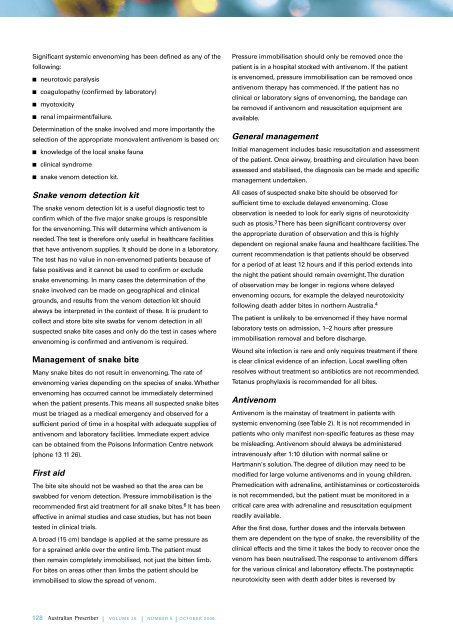download the full PDF issue - Australian Prescriber
download the full PDF issue - Australian Prescriber
download the full PDF issue - Australian Prescriber
You also want an ePaper? Increase the reach of your titles
YUMPU automatically turns print PDFs into web optimized ePapers that Google loves.
Significant systemic envenoming has been defined as any of <strong>the</strong><br />
following:<br />
■ neurotoxic paralysis<br />
■ coagulopathy (confirmed by laboratory)<br />
■ myotoxicity<br />
■ renal impairment/failure.<br />
Determination of <strong>the</strong> snake involved and more importantly <strong>the</strong><br />
selection of <strong>the</strong> appropriate monovalent antivenom is based on:<br />
■ knowledge of <strong>the</strong> local snake fauna<br />
■ clinical syndrome<br />
■ snake venom detection kit.<br />
Snake venom detection kit<br />
The snake venom detection kit is a useful diagnostic test to<br />
confirm which of <strong>the</strong> five major snake groups is responsible<br />
for <strong>the</strong> envenoming. This will determine which antivenom is<br />
needed. The test is <strong>the</strong>refore only useful in healthcare facilities<br />
that have antivenom supplies. It should be done in a laboratory.<br />
The test has no value in non-envenomed patients because of<br />
false positives and it cannot be used to confirm or exclude<br />
snake envenoming. In many cases <strong>the</strong> determination of <strong>the</strong><br />
snake involved can be made on geographical and clinical<br />
grounds, and results from <strong>the</strong> venom detection kit should<br />
always be interpreted in <strong>the</strong> context of <strong>the</strong>se. It is prudent to<br />
collect and store bite site swabs for venom detection in all<br />
suspected snake bite cases and only do <strong>the</strong> test in cases where<br />
envenoming is confirmed and antivenom is required.<br />
Management of snake bite<br />
Many snake bites do not result in envenoming. The rate of<br />
envenoming varies depending on <strong>the</strong> species of snake. Whe<strong>the</strong>r<br />
envenoming has occurred cannot be immediately determined<br />
when <strong>the</strong> patient presents. This means all suspected snake bites<br />
must be triaged as a medical emergency and observed for a<br />
sufficient period of time in a hospital with adequate supplies of<br />
antivenom and laboratory facilities. Immediate expert advice<br />
can be obtained from <strong>the</strong> Poisons Information Centre network<br />
(phone 13 11 26).<br />
First aid<br />
The bite site should not be washed so that <strong>the</strong> area can be<br />
swabbed for venom detection. Pressure immobilisation is <strong>the</strong><br />
recommended first aid treatment for all snake bites. 6 It has been<br />
effective in animal studies and case studies, but has not been<br />
tested in clinical trials.<br />
A broad (15 cm) bandage is applied at <strong>the</strong> same pressure as<br />
for a sprained ankle over <strong>the</strong> entire limb. The patient must<br />
<strong>the</strong>n remain completely immobilised, not just <strong>the</strong> bitten limb.<br />
For bites on areas o<strong>the</strong>r than limbs <strong>the</strong> patient should be<br />
immobilised to slow <strong>the</strong> spread of venom.<br />
128 | VOLUME 29 | NUMBER 5 | OCTOBER 2006<br />
Pressure immobilisation should only be removed once <strong>the</strong><br />
patient is in a hospital stocked with antivenom. If <strong>the</strong> patient<br />
is envenomed, pressure immobilisation can be removed once<br />
antivenom <strong>the</strong>rapy has commenced. If <strong>the</strong> patient has no<br />
clinical or laboratory signs of envenoming, <strong>the</strong> bandage can<br />
be removed if antivenom and resuscitation equipment are<br />
available.<br />
General management<br />
Initial management includes basic resuscitation and assessment<br />
of <strong>the</strong> patient. Once airway, breathing and circulation have been<br />
assessed and stabilised, <strong>the</strong> diagnosis can be made and specific<br />
management undertaken.<br />
All cases of suspected snake bite should be observed for<br />
sufficient time to exclude delayed envenoming. Close<br />
observation is needed to look for early signs of neurotoxicity<br />
such as ptosis. 3 There has been significant controversy over<br />
<strong>the</strong> appropriate duration of observation and this is highly<br />
dependent on regional snake fauna and healthcare facilities. The<br />
current recommendation is that patients should be observed<br />
for a period of at least 12 hours and if this period extends into<br />
<strong>the</strong> night <strong>the</strong> patient should remain overnight. The duration<br />
of observation may be longer in regions where delayed<br />
envenoming occurs, for example <strong>the</strong> delayed neurotoxicity<br />
following death adder bites in nor<strong>the</strong>rn Australia. 4<br />
The patient is unlikely to be envenomed if <strong>the</strong>y have normal<br />
laboratory tests on admission, 1–2 hours after pressure<br />
immobilisation removal and before discharge.<br />
Wound site infection is rare and only requires treatment if <strong>the</strong>re<br />
is clear clinical evidence of an infection. Local swelling often<br />
resolves without treatment so antibiotics are not recommended.<br />
Tetanus prophylaxis is recommended for all bites.<br />
Antivenom<br />
Antivenom is <strong>the</strong> mainstay of treatment in patients with<br />
systemic envenoming (see Table 2). It is not recommended in<br />
patients who only manifest non-specific features as <strong>the</strong>se may<br />
be misleading. Antivenom should always be administered<br />
intravenously after 1:10 dilution with normal saline or<br />
Hartmann's solution. The degree of dilution may need to be<br />
modified for large volume antivenoms and in young children.<br />
Premedication with adrenaline, antihistamines or corticosteroids<br />
is not recommended, but <strong>the</strong> patient must be monitored in a<br />
critical care area with adrenaline and resuscitation equipment<br />
readily available.<br />
After <strong>the</strong> first dose, fur<strong>the</strong>r doses and <strong>the</strong> intervals between<br />
<strong>the</strong>m are dependent on <strong>the</strong> type of snake, <strong>the</strong> reversibility of <strong>the</strong><br />
clinical effects and <strong>the</strong> time it takes <strong>the</strong> body to recover once <strong>the</strong><br />
venom has been neutralised. The response to antivenom differs<br />
for <strong>the</strong> various clinical and laboratory effects. The postsynaptic<br />
neurotoxicity seen with death adder bites is reversed by

















